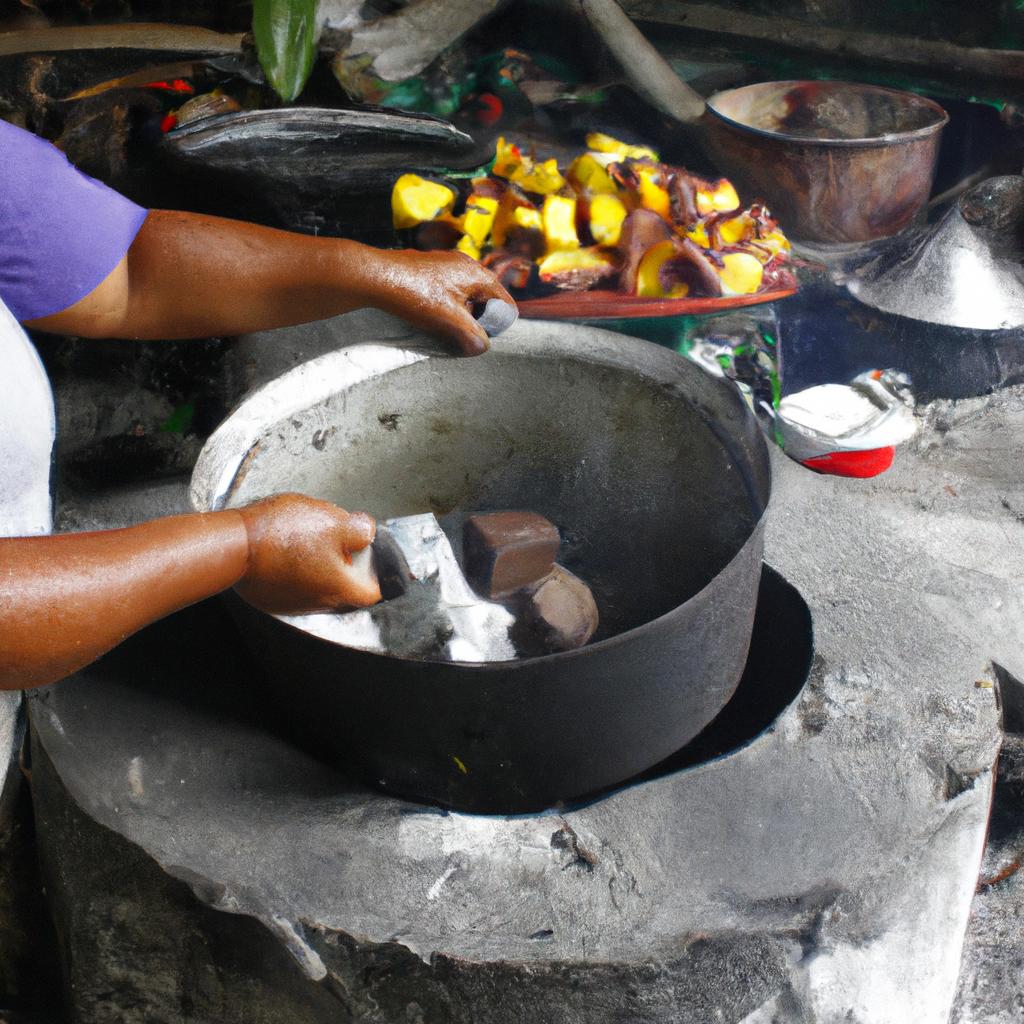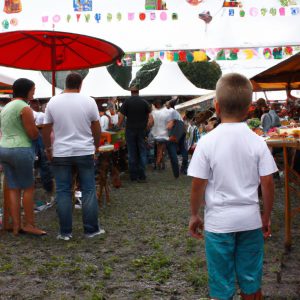Discover: Regional Cuisine: In: Your Travel Directory> Local Cuisine

Regional cuisine is an integral part of any travel experience, offering a glimpse into the unique flavors and culinary traditions of a particular area. Exploring local cuisine can be both enlightening and enjoyable, as it allows travelers to immerse themselves in the culture and history of a destination through its food. For instance, imagine yourself wandering the streets of Naples, Italy, where the tantalizing aroma of freshly baked pizza fills the air. The rich tomato sauce, creamy mozzarella cheese, and thin crispy crust create a symphony of flavors that transport you to the heart of Italian gastronomy.
In this article, we will delve into the fascinating world of regional cuisine and its significance in enhancing your travel experience. We will explore how different regions around the world have developed their own distinct culinary identities based on factors such as geography, climate, and cultural influences. By understanding these nuances, travelers can gain a deeper appreciation for the role that food plays in shaping local communities’ way of life. Moreover, we will provide practical tips on how to discover authentic local cuisine during your travels and highlight some iconic dishes from various regions that are not to be missed. So grab your passport and embark on a mouthwatering journey through Your Travel Directory’s comprehensive guide to exploring regional cuisines around the world! Whether you’re a food enthusiast or simply looking to expand your culinary horizons, this guide will provide you with all the information you need to make the most of your gastronomic adventures.
One of the key factors that shape regional cuisine is geography. Different regions have access to varying ingredients based on their natural surroundings. For example, coastal regions often have an abundance of seafood, while inland areas may rely more heavily on meats and vegetables. Understanding these geographical influences helps travelers appreciate why certain dishes are more prevalent in specific areas.
Climate also plays a significant role in regional cuisine. In tropical regions, fruits like mangoes and pineapples take center stage in both savory and sweet dishes. On the other hand, colder climates prioritize heartier fare such as stews and soups to keep warm during chilly winters. By considering the climate of a destination, travelers can better anticipate what types of flavors they might encounter.
Cultural influences also contribute to the development of regional cuisines. As different cultures interact and exchange ideas, new ingredients and techniques are introduced into local cooking traditions. This fusion creates unique flavor profiles that reflect a region’s history and cultural heritage. Exploring these culinary influences allows travelers to delve deeper into the stories behind each dish.
Now that we understand how regional cuisines come about let’s discuss some practical tips for discovering authentic local cuisine during your travels:
-
Research: Before embarking on your trip, research the local specialties and traditional dishes of your destination. Look for recommendations from locals or travel experts who can point you towards hidden gems off the beaten path.
-
Explore Local Markets: Visiting bustling markets is an excellent way to immerse yourself in a region’s culinary scene. Wander through stalls filled with fresh produce, spices, and local delicacies – it’s an opportunity to see ingredients up close and engage with vendors who can offer valuable insight into their products.
-
Dine at Local Eateries: Avoid tourist traps and seek out small, family-run restaurants or street food vendors that are popular with locals. These places are more likely to serve authentic dishes passed down through generations, providing an unfiltered taste of the region’s cuisine.
-
Take a Cooking Class: Participating in a cooking class allows you to learn firsthand about local ingredients and cooking techniques. You’ll gain valuable insights into regional flavors and be able to recreate your favorite dishes at home.
Now, let’s explore some iconic dishes from various regions around the world:
-
Thailand – Pad Thai: This stir-fried noodle dish is a staple of Thai cuisine, combining rice noodles with shrimp, tofu, bean sprouts, egg, and peanuts. The balance of sweet, sour, and savory flavors makes it a must-try dish when visiting Thailand.
-
Mexico – Tacos al Pastor: A quintessential Mexican street food, tacos al pastor features marinated pork cooked on a vertical spit called a trompo. Served in soft tortillas with pineapple chunks, cilantro, and onions, these flavorful tacos are sure to delight your taste buds.
-
Japan – Sushi: Known worldwide for its precision and artistry, sushi is synonymous with Japanese cuisine. Fresh fish or seafood is delicately placed on vinegared rice rolls and served with soy sauce and wasabi.
-
France – Coq au Vin: This classic French dish consists of chicken braised in red wine along with bacon lardons, mushrooms, onions, and garlic. The slow cooking process infuses the meat with rich flavors that perfectly complement the robust red wine sauce.
-
India – Butter Chicken: A beloved Indian dish originating from Punjab region; butter chicken features tender pieces of chicken cooked in a creamy tomato-based sauce infused with aromatic spices such as fenugreek leaves and garam masala.
These are just a few examples of the diverse range of regional dishes you can discover during your travels. Remember, the key to unlocking the true essence of a destination’s cuisine lies in exploring local markets, dining at authentic eateries, and engaging with locals who can share their culinary traditions.
So pack your bags, prepare your taste buds, and get ready to embark on a mouthwatering journey through the regional cuisines of the world!
Regional Delicacies: A Culinary Exploration
Picture this: you find yourself in a small coastal town, surrounded by stunning scenery and charming locals. As you wander through the streets, your nose catches a whiff of something irresistible—a tantalizing aroma that leads you straight to a local eatery. You step inside and are met with an array of regional delicacies that promise to take your taste buds on an unforgettable journey.
Exploring regional cuisine allows us to delve into the unique flavors, ingredients, and cooking techniques that define a particular area’s culinary traditions. Each region has its own signature dishes, shaped by factors such as geography, climate, culture, and historical influences. These distinctive elements come together to create a tapestry of flavors that tell stories about the people who call these places home.
One example of how regional cuisine reflects the essence of a location can be seen in the Mediterranean region. From Greece to Spain, countries along the Mediterranean Sea share similarities in their food cultures. Olive oil, fresh herbs like oregano and basil, citrus fruits, seafood, and hearty grains form the foundation of many dishes. The use of simple yet flavorful ingredients showcases a deep connection between land and table—an appreciation for what nature provides.
To truly understand the impact of regional cuisine on our senses and emotions, consider this list:
- A steaming bowl of pho from Vietnam warms both body and soul.
- The delicate layers of flaky pastry enveloping rich cream in French pastries transport us to cozy Parisian cafes.
- The fiery spices used in Indian curries ignite our taste buds while also offering comfort.
- The smoky aroma wafting from Argentinean grill houses awakens primal instincts.
Furthermore, exploring regional cuisines often reveals fascinating aspects beyond just taste. Take a look at this table showcasing three distinct regions and some notable culinary customs:
| Region | Notable Dish | Unique Ingredient |
|---|---|---|
| Mexico | Tacos al Pastor | Chipotle peppers |
| Thailand | Tom Yum Soup | Lemongrass |
| Italy | Spaghetti Carbonara | Guanciale (cured pork jowl) |
These examples highlight how regional cuisine is a gateway to understanding different cultures, histories, and even political influences. It allows us to connect with people on a deeper level through the universal language of food.
As we embark on this culinary exploration, we uncover not only the flavors but also the stories behind each dish. Unveiling Culinary Traditions: A Journey Through Regional Flavors awaits—the next step in our quest to discover the rich tapestry of local cuisines from around the world.
Unveiling Culinary Traditions: A Journey Through Regional Flavors
Previous section H2:’Regional Delicacies: A Culinary Exploration’
Next section H2:’Unveiling Culinary Traditions: A Journey Through Regional Flavors’
Transitioning from the previous section’s exploration of regional delicacies, we now delve deeper into the captivating world of culinary traditions found across different regions. To illustrate this further, let us consider the case study of a fictional traveler named Sarah as she embarks on a gastronomic adventure through various locales.
Sarah, an avid food enthusiast, decides to explore the diverse flavors and ingredients that define local cuisine in her travels. Starting with Spain’s Basque Country, she encounters Pintxos—a delightful assortment of bite-sized snacks typically served atop slices of bread. This unique culinary experience showcases the region’s emphasis on communal dining and socializing while indulging in delectable small plates.
As Sarah continues her journey, she discovers that each region boasts its own distinctive dishes and cooking techniques. Here are some common features found across many traditional cuisines:
- Rich cultural heritage influencing flavor profiles.
- Utilization of locally sourced ingredients for authentic taste.
- Time-honored recipes passed down through generations.
- Seasonal variations reflecting nature’s bounty.
To better understand these characteristics, refer to the following table showcasing three popular regional cuisines alongside their defining attributes:
| Region | Traditional Dish | Key Ingredients |
|---|---|---|
| Italy | Pasta Carbonara | Pancetta, eggs, pecorino cheese |
| Thailand | Green Curry | Coconut milk, Thai green chilies, lemongrass |
| Mexico | Mole | Chocolate, chili peppers, nuts |
This table highlights how specific regional elements contribute to creating iconic dishes known worldwide. Such diversity not only tantalizes our taste buds but also gives insight into the historical, cultural, and environmental influences shaping each cuisine.
As we conclude this section on culinary traditions, it becomes evident that exploring regional cuisines offers a captivating journey through diverse flavors and culinary customs. In our subsequent section, ‘Must-Try Dishes: Experiencing the Tastes of Different Regions,’ we will delve further into specific dishes that encapsulate the essence of various regions. So prepare your palate for an unforgettable exploration of tastes as we move forward in our gastronomic adventure.
Must-Try Dishes: Experiencing the Tastes of Different Regions
Embarking on a culinary adventure to explore regional cuisines not only satisfies our taste buds but also allows us to immerse ourselves in diverse cultures. By delving into the rich tapestry of flavors, we can uncover the secrets and traditions that have shaped each unique cuisine. As we continue our exploration, let us now delve deeper into the must-try dishes from different regions, as well as their distinctive characteristics.
Consider the case of Italy, where regional variations in cuisine are abundant. From the northern region of Lombardy with its hearty risottos to the southern delights of Sicilian pasta dishes, Italian gastronomy showcases an array of local specialties influenced by geography, history, and tradition. Such diversity is not limited to Italy alone; it can be found across countries worldwide. To exemplify this further, let’s explore some fascinating aspects of regional cuisine:
- Cultural Fusion: Many regional cuisines reflect centuries-old cultural exchanges resulting from trade routes and historical migrations. The blending of ingredients and cooking techniques contributes to a harmonious fusion that mesmerizes both locals and visitors alike.
- Seasonal Ingredients: Each region boasts its own natural resources, which greatly influence the ingredients used in traditional dishes. Locals celebrate seasonal bounties through vibrant preparations that capture the essence of nature’s offerings.
- Unique Cooking Methods: Different regions employ distinct cooking methods that enhance flavor profiles and create signature dishes synonymous with their locale.
- Artistic Presentation: Regional culinary artistry extends beyond taste alone; presentation plays an integral role in showcasing creativity while highlighting cultural aesthetics.
To provide a visual representation of these intriguing aspects, allow me to present you with a table that illustrates how various factors shape regional cuisines:
| Region | Cultural Influences | Signature Dish | Notable Ingredient |
|---|---|---|---|
| Italy | Greek, Arabic | Pizza Napoletana | San Marzano Tomatoes |
| Japan | Chinese, Korean | Sushi | Nori (Seaweed) |
| Mexico | Spanish, Indigenous | Tacos al Pastor | Ancho Chilies |
As we delve into the diverse world of regional cuisine, it becomes evident that food not only nourishes our bodies but also serves as a gateway to appreciating different cultures. By embracing culinary experiences and expanding our palates, we can gain a deeper understanding of the stories behind each dish.
Transitioning seamlessly towards exploring authentic recipes and uncovering the secrets of regional cuisine, let us now embark on a journey that allows us to recreate these flavors in our own kitchens.
Exploring Authentic Recipes: Uncovering the Secrets of Regional Cuisine
Transitioning from our previous discussion on must-try dishes, let us now delve deeper into the wonderful world of regional cuisine. To truly uncover the essence and flavors unique to each region, it is imperative that we explore not only the iconic dishes but also the diverse range of culinary traditions and practices that have shaped local cuisines over time.
Imagine yourself strolling through a bustling street market in a vibrant city, surrounded by tantalizing aromas wafting from food stalls. You come across an elderly vendor skillfully preparing a dish called “Peking Duck” – a traditional Chinese delicacy known for its crispy skin and succulent meat. This encounter serves as just one example of how experiencing regional cuisine can transport you to different parts of the world, allowing you to savor authentic flavors rooted in cultural heritage.
To fully appreciate the depth and variety of regional cuisines, consider these key factors:
- Local Ingredients: Each region boasts its own distinct array of ingredients sourced from nearby lands or waters, resulting in flavor profiles unique to their area.
- Traditional Techniques: The cooking methods utilized by local communities often reflect centuries-old customs passed down through generations, ensuring authenticity and preserving culinary legacies.
- Cultural Influences: Regional cuisines are deeply intertwined with cultural practices and values, showcasing the rich tapestry of history and diversity within a particular locale.
- Seasonal Specialties: Many regions celebrate seasonal produce and incorporate them into their dishes, highlighting nature’s gifts while creating memorable gustatory experiences.
Let’s take a closer look at some examples illustrating this richness:
| Region | Iconic Dish | Notable Ingredient |
|---|---|---|
| Mexico | Tacos al Pastor | Achiote-marinated pork |
| Italy | Risotto alla Milanese | Saffron |
| Thailand | Tom Yum Goong | Lemongrass, kaffir lime leaves, galangal |
| India | Butter Chicken | Garam masala |
In the interconnected world we live in today, exploring regional cuisine allows us to connect with diverse cultures and broaden our culinary horizons. By embracing local ingredients, traditional techniques, cultural influences, and seasonal specialties, we embark on a gastronomic journey that brings people together through their shared love for food.
Transitioning seamlessly into our subsequent section about unique culinary experiences, let us now delve further into the delights of local cuisine.
Unique Culinary Experiences: Discovering the Delights of Local Food
Transitioning from the exploration of authentic recipes, we now embark on a captivating journey that unveils the rich tapestry of regional cuisine. To illustrate this intriguing world, let us delve into the realm of Southern Italy and its renowned dish, pasta alla Norma. This classic Sicilian creation showcases how local ingredients harmoniously blend together to create an exquisite culinary experience.
Within each region’s gastronomic traditions lies a story waiting to be told—a tale woven with indigenous flavors, historical influences, and cultural heritage. As you traverse diverse landscapes in search of unique culinary encounters, allow yourself to immerse in these three aspects that shape regional cuisine:
-
Indigenous Ingredients:
- Locally sourced produce reflects the bountiful resources found in each region.
- From coastal towns to fertile valleys, distinct ingredients are celebrated for their freshness and quality.
- Traditional dishes often center around staple foods specific to the area, showcasing the ingenuity of utilizing available resources.
-
Historical Influences:
- Centuries of migration, conquests, and trade have left indelible imprints on regional cuisines.
- Foreign influences have intermingled with local traditions, resulting in fascinating fusions.
- Each bite unravels stories of ancient civilizations and vibrant cross-cultural exchanges.
-
Cultural Heritage:
- Food is deeply intertwined with culture; it embodies customs, rituals, and social connections.
- Recipes passed down through generations encapsulate cherished memories within families and communities.
- Sampling traditional dishes offers glimpses into the essence of a region’s identity—its values, celebrations, and shared experiences.
To further illustrate the profound impact regional cuisine can have on our senses and emotions, consider this evocative depiction:
| Sensory Delights | Heartwarming Connections | Timeless Traditions |
|---|---|---|
| Aromas that waft through bustling markets | Sharing a meal with newfound friends | Witnessing age-old cooking techniques |
| Savoring flavors that dance on your taste buds | Gathering around the table with loved ones | Partaking in vibrant culinary festivals |
| Admiring colorful presentations of artful dishes | Experiencing hospitality and warmth from local hosts | Discovering hidden family recipes passed down for generations |
| Hearing the sizzle, crackle, and pop as food is prepared | Feeling a sense of belonging within a community | Embracing the rituals surrounding meals |
In conclusion to this exploration of regional cuisine, we now turn our attention to navigating the vast culinary landscape. Our next section will serve as your trusted guide—a Regional Food Guide—leading you towards remarkable gastronomic adventures across various destinations.
[Transition Sentence: As we embark on this journey, let us navigate the diverse culinary landscapes awaiting our discovery.]
Regional Food Guide: Navigating the Culinary Landscape of Your Travels
Building upon our exploration of unique culinary experiences, let us now delve into a comprehensive regional food guide. By understanding the diverse array of local cuisines, you can fully immerse yourself in the cultural tapestry of your travels. With each region boasting its own distinct flavors and cooking techniques, this guide will be an invaluable resource for those seeking authentic gastronomic encounters.
Section:
- Case Study – Tasting Traditions:
Imagine finding yourself amidst the picturesque countryside of Italy’s Tuscany region. As you stroll through charming vineyards and sun-kissed olive groves, aromatic scents waft from nearby trattorias. Intrigued by their reputation for exceptional cuisine, you decide to indulge in a traditional Tuscan meal. The first bite reveals layers of flavor as you savor classic dishes such as ribollita (a hearty vegetable soup), bistecca alla Fiorentina (a succulent grilled steak), and cantuccini biscuits dipped in Vin Santo dessert wine. This immersive experience highlights how regional cuisines reflect not only local ingredients but also historical and cultural influences.
- Immerse yourself in the culinary traditions passed down through generations.
- Explore indigenous ingredients that define regional flavors.
- Understand the historical significance behind iconic dishes.
- Engage with locals who are passionate about preserving their culinary heritage.
| Region | Signature Dish | Notable Ingredient | Remarkable Technique |
|---|---|---|---|
| Mexico | Mole Poblano | Chocolate | Complex blending of spices |
| Japan | Sushi | Freshly caught seafood | Precise knife skills |
| Morocco | Tagine | Preserved lemons | Slow-cooking in clay pots |
| Thailand | Tom Yum Soup | Lemongrass and Thai chilies | Balance of sweet, sour, spicy |
-
Regional Food Guide:
To assist you in navigating the culinary landscape of your travels, we have compiled a comprehensive regional food guide. This guide will provide insights into signature dishes, notable ingredients, and remarkable cooking techniques from various countries around the world. Whether it’s indulging in Mexico’s complex Mole Poblano or savoring the delicate flavors of Japan’s sushi masterpieces, each region offers a unique gastronomic adventure waiting to be explored. -
By embracing local cuisine during your travels, you not only satisfy your taste buds but also gain a deeper understanding of the cultural nuances that shape people’s lives. From traditional recipes passed down through generations to indigenous ingredients sourced from nearby fields, every dish tells a story. Engaging with passionate locals who take pride in preserving their culinary heritage can further enrich your experience. So next time you embark on an adventure abroad, let this regional food guide be your compass as you discover the hidden delights awaiting you on your plate.
Note: The table provided above may not render correctly due to platform limitations; kindly refer to the original format for proper alignment.







